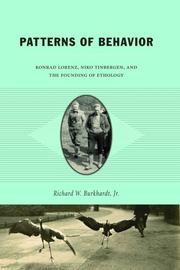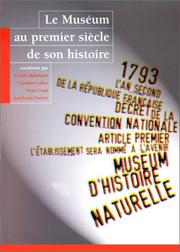| Listing 1 - 2 of 2 |
Sort by
|

ISBN: 0226080900 9780226080901 9780226080895 0226080897 Year: 2005
Abstract | Keywords | Export | Availability | Bookmark
 Loading...
Loading...Choose an application
- Reference Manager
- EndNote
- RefWorks (Direct export to RefWorks)
It is hard to imagine, by their very name, the life sciences not involving the study of living things, but until the twentieth century much of what was known in the field was based primarily on specimens that had long before taken their last breaths. Only in the last century has 'ethology'--the study of animal behavior--emerged as a major field of the life sciences. In 'Patterns of Behavior', Richard W. Burkhardt Jr. traces the scientific theories, practices, subjects, and settings integral to the construction of a discipline pivotal to our understanding of the diversity of life. Central to this tale are Konrad Lorenz and Niko Tinbergen, 1973 Nobel laureates whose research helped legitimize the field of ethology and bring international attention to the culture of behavioral research. Demonstrating how matters of practice, politics, and place all shaped "ethology's ecologies," Burkhardt's book offers a sensitive reading of the complex interplay of the field's celebrated pioneers and a richly textured reconstruction of ethology's transformation from a quiet backwater of natural history to the forefront of the biological sciences.
Animal ethology and ecology. Sociobiology --- Lorenz, Konrad --- Tinbergen, Niko --- Animal behavior --- History. --- Lorenz, Konrad, --- Tinbergen, Niko, --- Animaux --- History --- Moeurs et comportement --- Histoire --- Animals --- Animals, Habits and behavior of --- Behavior, Animal --- Ethology --- Animal psychology --- Zoology --- Ethologists --- Psychology, Comparative --- Behavior


ISBN: 285653516X 9782856535165 2856538452 Year: 2019 Volume: *1 Publisher: Paris : Publications scientifiques du Muséum,
Abstract | Keywords | Export | Availability | Bookmark
 Loading...
Loading...Choose an application
- Reference Manager
- EndNote
- RefWorks (Direct export to RefWorks)
1793. En pleine Terreur, la Convention nationale crée le Muséum national d’Histoire naturelle. Le décret du 10 juin confie, à ce qui fut le Jardin du roi, la tâche d’enseigner les sciences naturelles au peuple. Le présent ouvrage retrace les grandes étapes du développement du Muséum en tant qu’Institution, en tant qu’organisme de recherches et en tant que modèle pour l’Europe et le monde. Sur un siècle d’histoire, défilent les difficultés de sa construction administrative dans un contexte politique mouvementé, l’organisation et le développement du travail scientifique de ses savants, la participation de l’établissement aux grandes missions de découvertes comme aux débats scientifiques qui agitent le monde de cette époque. Un siècle, trois générations c’est beaucoup et c’est peu, de la période cruciale de sa fondation, à l’« âge d’or » jusqu’en 1850, jusqu’à la période incertaine précédant la 1ère Guerre mondiale. Ce livre, qui se présente sous forme de contributions d’éminents spécialistes d’histoire des sciences, aborde dans une langue claire et accessible l’histoire des idées et l’histoire d’une institution prestigieuse. À cet égard, son public est aussi vaste que celui qui fréquente le Muséum : chercheurs du monde entier, connaisseurs du patrimoine, amoureux du Jardin des Plantes.
history --- France --- museums --- natural history --- P institute --- Natural history museums --- Natural history --- History, Natural --- Natural science --- Physiophilosophy --- Biology --- Science --- Science museums --- History --- Museums --- Muséum national d'histoire naturelle (France) --- Musée d'histoire naturelle (France) --- Muséum d'histoire naturelle (France) --- Musée national d'histoire naturelle (France) --- Paris. --- France. --- Músaem Náisiúnta na Staire Aiceanta (France) --- Muséum d'histoire naturelle de Paris --- French National Museum of Natural History --- National Museum of Natural History (France) --- Museum of Natural History (France) --- MNHN --- Jardin du roi (France) --- History. --- muséologie --- Muséum national d'Histoire naturelle
| Listing 1 - 2 of 2 |
Sort by
|

 Search
Search Feedback
Feedback About
About Help
Help News
News